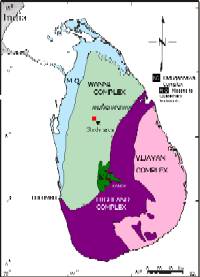Special Program for International Students
GRADUATE COURSE IN EARTH SCIENCE
& GEOENVIRONMENTAL SCIENCE
Current MEXT students
M.A.Geeth Mahinada Manthilake (Sri Lanka)
Email: geethmm @hotmail.com,
s039210 @matsu.shimane-u.ac.jp
Thesis title: Petrological study of apatite-bearing carbonatites and their xenoliths, Eppawala, Sri Lanka.
Supervisor: Prof. Y. Sawada (2003-2005).
The Eppawala carbonatite bodies are located in Eppawala, north central Sri Lanka, lying about 200 Km from the capital city of Colombo. These apatite-bearing carbonate rocks occur as massive, discontinuous bodies in a Precambrian, high-grade metamorphic terrain (Wanni Complex). They are associated with migmatitic gneisses, granitic gneisses, charnockitic gneisses, and quartzite, and field relations show that the carbonatites are younger than the surrounding country rocks. The carbonatite rocks consist mainly of apatite (1-15 %), calcite, dolomite, ore minerals (< 10 %) and minor amounts of ilmenite, magnetite, pyrite, forsterite, phlogopite enstatite, magnetite, diopside, tremolite, rutile, fluorite and spinel.
Although much research has been carried out on various aspects of the Eppawala carbonatite, no studies have yet focused on the xenoliths found in the carbonatites. Furthermore, melt inclusions and volatile components found in the carbonatite have not been investigated in detail. It is thus important to study these phases to draw firm conclusions on the genesis of the carbonatites.
During my study, petrography of the xenoliths, apatites and carbonatites will be examined by microscope and EPMA. Bulk rock chemistry will be determined by XRF, GC, GC-MS, and FT-IR analyses will be made of carbonaceous materials. CHNS analysis and C and O isotope study will also be important aspects of my research. The resulting petrological and geochemical data will be used to interpret the source materials as well as the source region of the carbonatite rocks, and the magmatic or other processes that operated during and after the rock formation.


